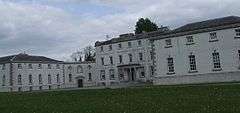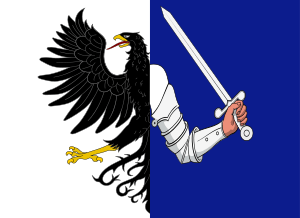Strokestown Park
Strokestown Park House is a Palladian villa in Strokestown, County Roscommon, Ireland, set on about 300 acres (120 ha).
| Strokestown Park | |
|---|---|
 Strokestown Park House in 2011 | |
 | |
| General information | |
| Town or city | Strokestown |
| Country | Ireland |
| Coordinates | 53.777°N 8.104°W |
The house is open to the public, as is the Famine Museum on the grounds.
History
The house was the family home of the Cromwellian "adventurer" family - the Pakenham Mahons - from the 1600s until 1979.
By the early 18th century, the estate comprised over 11,000 acres (4,500 ha), scattered throughout north east Roscommon, put together from the later seventeenth century as a result of land acquisitions by Captain Nicholas Mahon around 1660. Later, his great-grandson, Maurice Mahon, purchased several additional lands, following elevation to the Peerage of Ireland as the first Baron Hartland in 1800.
Many evictions of poor tenant farmers occurred during the Great Famine. The Mahon family alone in 1847 evicted 3,000 people.[1] After the killing of Major Denis Mahon in November 1847, as a direct reaction to the large scale deaths of those sent on famine ships to Canada by the Strokestown estate [2] at the height of the Famine, his only daughter, Grace Catherine, vowed never to return to her ancestral seat. She was on honeymoon at the time, having been married only weeks earlier, to Henry Sandford Pakenham, son of Dean Henry Pakenham of Tullynally, and heir to the vast Pakenham and Sandford estates in counties Longford, Westmeath and Roscommon. Grace Catherine never returned to Strokestown, but her marriage undoubtedly saved the estate from bankruptcy. On the eve of the Famine, the estate was in debt with over £30,000 having accrued as a result of family dispute over inheritance[3] and expensive land purchases which had gathered from the second half of the eighteenth century.[4] The marriage alliance (by which Henry Sandford Pakenham assumed the additional surname of Mahon), united the estates of both families to comprise over 26,000 acres, and the Strokestown estate remained one of the largest in Roscommon until his death in 1893. The Pakenham fortune also enabled large scale investment in various estate improvement projects on the Strokestown estate, including drainage, turf cutting and agricultural schemes, development of the urban market in the town of Strokestown. However, despite the family fortunes improving Strokestown continued a policy of forced emigration to the United States and land clearances of tenant families.
Since 1979, Strokestown Park has been owned by a Roscommon-based company, the Westward Group which has restored the house and gardens using largely original furnishings. The 4-acre (1.6 ha) walled pleasure garden was officially opened in 1997 by the President of Ireland, Mary Robinson, having been faithfully restored with the assistance of an ERDF grant through the Great Gardens of Ireland Restoration Programme and a FÁS scheme.
Strokestown Park House was the setting for TV3's 2013 documentary, The Big House.
National Famine Museum
Today, the Strokestown estate is synonymous with the Great Famine and includes the National Irish Famine Museum. The museum contains some of the best records from the time of the Famine.[5] The museum was built by the Westward Group and all the documents on display in the museum are from the estate. The exhibit aims to explain the Great Irish Famine and to draw parallels with the occurrence of famine in the world today.[6]
References
- History of Ireland (2008), History Ireland, Volume 16 (No.6 (November–December 2008))
- http://www.rte.ie/radio/utils/radioplayer/rteradioweb.html#!rii=9%3A10423868%3A0%3A%3A
- http://www.rte.ie/radio/utils/radioplayer/rteradioweb.html#!rii=9%3A10423868%3A0%3A%3A
- History Ireland, Volume 3, Issue 4.
- S. Hood, "Through the gates—power and profit in Strokestown, County Roscommon", in Finn-Einar Elissen and Geir Atle Ersland (eds.), Power, profit and urban land.
- Official website
